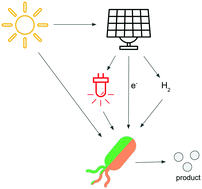当前位置:
X-MOL 学术
›
Energy Environ. Sci.
›
论文详情
Our official English website, www.x-mol.net, welcomes your feedback! (Note: you will need to create a separate account there.)
Many ways towards ‘solar fuel’: quantitative analysis of the most promising strategies and the main challenges during scale-up†
Energy & Environmental Science ( IF 32.5 ) Pub Date : 2017-10-13 00:00:00 , DOI: 10.1039/c7ee02212c D. Lips 1, 2, 3, 4, 5 , J. M. Schuurmans 4, 6, 7, 8, 9 , F. Branco dos Santos 1, 2, 3, 4, 5 , K. J. Hellingwerf 1, 2, 3, 4, 5
Energy & Environmental Science ( IF 32.5 ) Pub Date : 2017-10-13 00:00:00 , DOI: 10.1039/c7ee02212c D. Lips 1, 2, 3, 4, 5 , J. M. Schuurmans 4, 6, 7, 8, 9 , F. Branco dos Santos 1, 2, 3, 4, 5 , K. J. Hellingwerf 1, 2, 3, 4, 5
Affiliation

|
Future global needs for liquid energy carriers, commodity chemicals and renewable materials should no longer be covered by exploration of fossilized carbon deposits. Therefore, processes are urgently needed that can replace this source of carbon for the production of these materials. The alternative route of production most often referred to is via their synthesis from CO2 (and water), using the (free) energy of sunlight. This process has been intensely studied, particularly during the past decade, and has resulted in a wide range of proposed solutions. However, with the ultimate constraint that a limited surface area will be available on our planet to catch the necessary photons, the picture is emerging showing that three approaches turn out to be most promising to achieve commercial production of this range of products. Interestingly, they all exploit living cells to facilitate formation of essential, select, carbon–carbon bonds. In one approach, photovoltaic cells provide electricity to generate hydrogen that can be used for lithoautotrophy (or: ‘chemosynthesis’) in organisms like Cupriavidus or Clostridium. An alternative approach is to use solar-driven (i.e. large-surface area) photobioreactors for the growth of engineered cyanobacteria, to carry out ‘direct conversion’ of CO2 into products like ethanol, iso-butanol, lactic acid, etc. In a hybrid derivative of these two approaches renewable (solar) electricity may be converted into monochromatic light of ∼650 nm that is optimal to drive photosynthesis in cyanobacterial photobioreactors, equipped with internal LED illumination. Here we discuss strengths and weaknesses of these three approaches, analyse the range of products for which proof-of-principle production has been demonstrated, and compare a selection of such studies with respect to efficiency and productivity of the CO2-to-product conversion. As for all approaches large-scale application is crucial, we also discuss the pitfalls and limitations of their scale-up.
中文翻译:

实现“太阳能”的方式很多:对最有前途的策略进行定量分析,并在放大过程中面临主要挑战†
对化石碳矿藏的勘探将不再满足全球对液态能源载体,日用化学品和可再生材料的未来需求。因此,迫切需要能够替代这种碳源以生产这些材料的工艺。最常提及的替代生产途径是通过其从CO 2的合成(和水),利用阳光的(自由)能量。对该过程进行了深入的研究,尤其是在过去的十年中,并已导致提出了广泛的解决方案。但是,由于最终的局限性,我们星球上将只能使用有限的表面积来捕获必要的光子,因此出现的图片表明,三种方法被证明是实现该系列产品商业化生产的最有希望的方法。有趣的是,它们都利用活细胞来促进必不可少的碳-碳键的形成。在一种方法中,光伏电池提供电能以产生氢,该氢可用于诸如铜杯(Cupriavidus)或梭状芽胞杆菌(Clostridium)之类的生物体中的自养(或“化学合成”)。一种替代方法是使用太阳能驱动的(即大表面积)光生物反应器来生长工程蓝细菌,以将CO 2 “直接转化”为乙醇,异丁醇,乳酸等产品。这两种方法的混合衍生物可以将可再生(太阳能)电转换为约650 nm的单色光,该光最适合驱动配备内部LED照明的蓝藻光生物反应器中的光合作用。在这里,我们讨论了这三种方法的优缺点,分析了已证明原理性生产的产品范围,并比较了这些研究在CO 2效率和生产率方面的选择。到产品的转化。对于所有方法,大规模应用都是至关重要的,我们还将讨论其扩展的陷阱和局限性。
更新日期:2017-10-13
中文翻译:

实现“太阳能”的方式很多:对最有前途的策略进行定量分析,并在放大过程中面临主要挑战†
对化石碳矿藏的勘探将不再满足全球对液态能源载体,日用化学品和可再生材料的未来需求。因此,迫切需要能够替代这种碳源以生产这些材料的工艺。最常提及的替代生产途径是通过其从CO 2的合成(和水),利用阳光的(自由)能量。对该过程进行了深入的研究,尤其是在过去的十年中,并已导致提出了广泛的解决方案。但是,由于最终的局限性,我们星球上将只能使用有限的表面积来捕获必要的光子,因此出现的图片表明,三种方法被证明是实现该系列产品商业化生产的最有希望的方法。有趣的是,它们都利用活细胞来促进必不可少的碳-碳键的形成。在一种方法中,光伏电池提供电能以产生氢,该氢可用于诸如铜杯(Cupriavidus)或梭状芽胞杆菌(Clostridium)之类的生物体中的自养(或“化学合成”)。一种替代方法是使用太阳能驱动的(即大表面积)光生物反应器来生长工程蓝细菌,以将CO 2 “直接转化”为乙醇,异丁醇,乳酸等产品。这两种方法的混合衍生物可以将可再生(太阳能)电转换为约650 nm的单色光,该光最适合驱动配备内部LED照明的蓝藻光生物反应器中的光合作用。在这里,我们讨论了这三种方法的优缺点,分析了已证明原理性生产的产品范围,并比较了这些研究在CO 2效率和生产率方面的选择。到产品的转化。对于所有方法,大规模应用都是至关重要的,我们还将讨论其扩展的陷阱和局限性。



























 京公网安备 11010802027423号
京公网安备 11010802027423号